Identifying the Carex species of Renfrew County
The inflorescence is the primary feature of distinction between each Carex species. The inflorescence is made up of spikes or spikelets. These may be unisexual (staminate flowers on one spike and pistillate flowers on another spike) or bisexual (staminate and pistillate flowers sharing, but segregated upon, the same spike). The flowers are formed in the axil of a scale. The pistillate flowers are enclosed by a sac-like scale (the perigynium) and the seed (achene) develops within the perigynium. In most cases, the morphology of the perigynium along with the scale and achene is unique to each species; a mature inflorescence in hand with a 10x magnifying loupe will almost always clinch the id. For this reason, the photographs in the species pages will show each of these features in detail.
Of course, thumbing through more than 100 species tends to frustrate so means to quickly eliminate unlikely possibilities need to be developed. I avoid the standard keys because verbal descriptions are so easy to misinterpret and one has to wade through all of the species that don't even belong in your region. Treatments with keys for a subset of North American Carex species are somewhat more tractable. For example, the one developed by Andrew Hipp [Hipp, 2008] for the Carex of Wisconsin is much easier to follow. I highly recommend this book by Andrew Hipp as it provides excellent detail and discussion containing all but two Carex species found on our list from Renfrew County.
As a physicist, I have found it easier to apply some mathematical rigor and avoid some of the descriptive language that can be so cumbersome. For example, focusing on the symmetry elements of the perigynia and achenes quickly reduces the possible identities for a specimen. Taxonomists have divided the genus Carex into two subgenera: Carex subgenus Carex and Carex subgenus Vignea. Invariably, all species of Subgenus Carex have perigynia with a rotational axis of symmetry (botanists use the word "terete" to describe the perigynia of many of these species which means: cylindrical, tapering at the ends). Cross sections through the perigynia bodies of these species can have a two-, three- or multi-fold axes of rotational symmetry.
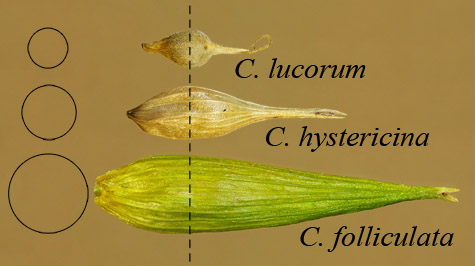
Examples of perigynia from Carex Subgenus Carex with circular cross sections (infinite-fold axis of rotation).
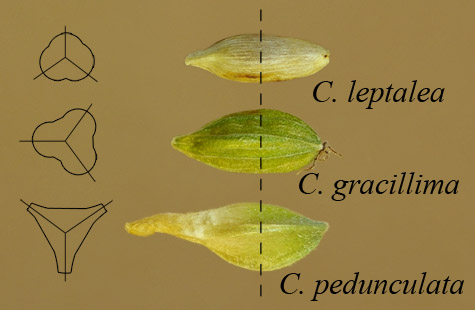
Examples of perigynia from Carex Subgenus Carex with a three-fold axis of rotation showing sketches of cross section.
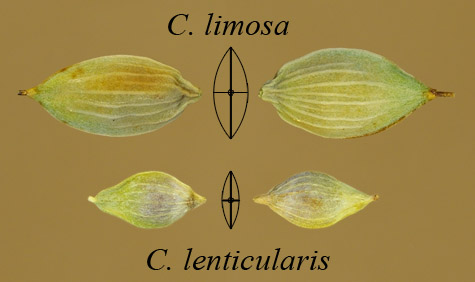
Examples of perigynia from Carex Subgenus Carex with lenticular cross sections (two-fold axis of rotation and both faces indistinguishable).
The periginia of Subgenus Vignea, on the other hand, possess only a vertical plane of reflection as the symmetry element. That is, the species in Subgenus Vignea are distinctly two-faced, usually with one concave and one convex face (generally thin and flattened) but sometimes plano-convex or having two faces with distinctly different degrees of convexity. One face is called "adaxial" (facing inward, towards the axis of the inflorescence) and the other face is called "abaxial" (facing outwards, away from the axis of the inflorescence). Accordingly, the achenes for all species in Subgenus Vignea are lenticular shaped, i.e., a two-fold axis of rotational symmetry.
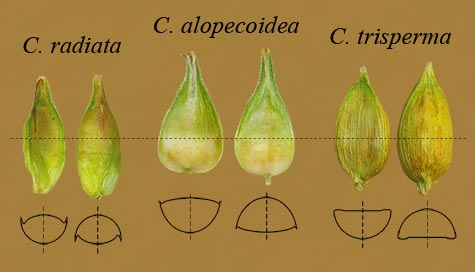
Examples of perigynia from Carex Subgenus Vignea. Cross sections at horizontal dotted line are sketched below the perigynia. Dashed vertical lines on cross section sketches show the plane of reflection. For each perigynia pair, the adaxial face is on the left and the abaxial face is on the right.
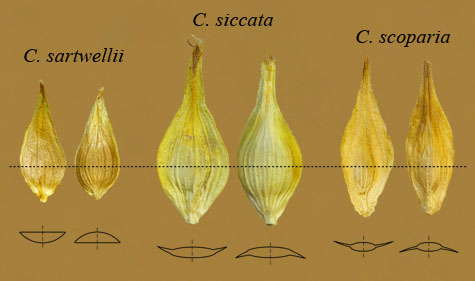
Examples of perigynia from Carex Subgenus Vignea. Cross sections at horizontal dotted line are sketched below the perigynia. Dashed vertical lines on cross section sketches show the plane of reflection. For each perigynia pair, the adaxial face is on the left and the abaxial face is on the right.
Acknowledging natural variability in the shapes as the achenes and perigynia develop (i.e., none of them possessing perfect symmetry), symmetry appears to be a highly successful means of separating Carex subgenus Carex and Carex subgenus Vignea. The rotational symmetry seems to derive from perigynia that develop from 3-carpellate ovaries (subgenus Carex) and the two-faced symmetry seems to derive from 2-carpellate ovaries (subgenus Vignea). Two exceptions are Section Bicolores and Section Phacocystis in subgenus Carex that are 2-carpellate with either lenticular or asymmetric achenes. Interestingly, the perigynia of Section Phacocystis have two-fold rotational symmetry and the perigynia of Section Bicolores have an infinite-fold rotational symmetry (circular cross-section). Historically, the number of stigmas (two for 2-carpellate or three for 3-carpellate) have been used to separate the Carex species. The stigmas are often not found intact in the field or on specimens so the symmetry seems to be a useful approach for identification, at least for those species I know from Renfrew County.
Amongst all of the Renfrew County species in Carex subgenus Vignea, the perigynia of Carex disperma are the only ones that could be mistaken for having rotational symmetry - all of the rest have two distinct faces and the vertical plane of reflection will not go unrecognized in these perigynia. Many perigynia of the Renfrew County Carex subgenus Carex species can be distorted enough to disguise the rotational symmetry but in no case would they display the character of two distinct faces.
The table below divides the Carex sections between the two subgenera. This table also includes detail about the inflorescences to further break down the sections. In particular, for Carex subgenus Carex, each spikelet is generally unisexual or dominated by either staminate or pistillate flowers. For Carex subgenus Vignea, the spikelets are sessile and generally bi-sexual; gynecandrous (staminate basal) or androgynous (staminate terminal).
Sections of Subgenus Carex and Subgenus Vignea with species in Renfrew County
Carex Subgenus Carex
|
Carex Subgenus Vignea
|
||
|---|---|---|---|
| Section Name | Comments | Section Name | Comments |
| PHYLLOSTACHYAE | 1 species | DIVISAE | Unisexual, 1 species |
| LEUCOGLOCHIN | 1 species | PHYSOGLOCHIN | Unisexual or androgynous, 1 species |
| LEPTOCEPHALAE | 1 species | HOLARRHENAE | Androgynous or unisexual, 1 species |
| CLANDESTINAE | 2 species | AMMOGLOCHIN | Androgynous, 1 species |
| ACROCYSTIS | 8 species | MULTIFLORAE | Androgynous, 1 species |
| LIMOSAE | 2 species | HELEOGLOCHIN | Androgynous, 2 species |
| POROCYSTIS | 1 species | VULPINAE | Androgynous, 2 species |
| ANOMALAE | 1 species | CHORDORRHIZAE | Androgynous, 1 species |
| RACEMOSAE | 1 species | PHAESTOGLOCHIN | Androgynous, 6 species |
| ALBAE | 1 species | DISPERMAE | Androgynous, 1 species |
| PANICEAE | 2 species | GLAREOSAE | Gynecandrous, 6 species |
| CERATOCYSTIS | 3 species | DEWEYANAE | Gynecandrous, 2 species |
| HYMENOCHLAENAE | 6 species | STELLULATAE | Gynecandrous, 3 species |
| LAXIFLORAE | 4 species | OVALES | Gynecandrous, 12 species |
| GRANULARES | 2 species | ||
| GRISEAE | 2 species | ||
| CAREYANAE | 2 species | ||
| BICOLORES | 2-carpellate, 1 species | ||
| PHACOCYSTIS | 2-carpellate, 6 species | ||
| VESICARIAE | 9 species | ||
| PALUDOSAE | 4 species | ||
| ROSTRALES | 2 species | ||
| CAREX | 1 species | ||
| HIRTIFOLIAE | 1 species | ||
| LUPULINAE | 2 species | ||
As stated earlier, a close look at the mature peryginia is the primary means of identification but seeing the plant as a whole organism is our goal. Appreciation for the Carex species compels us to also know the habit (its manner of growth) and not just the microscopic details. Habit features are often much more subtle and are best learned with time in the field. It is like learning to recognize a person's face.
References
Andrew L Hipp, Field Guide to Wisconsin Sedges: An Introduction to the Genus Carex (Cyperaceae), University of Wisconsin Press, 2008